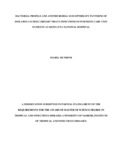| dc.contributor.author | Muthoni, Isabel | |
| dc.date.accessioned | 2016-04-27T12:28:10Z | |
| dc.date.available | 2016-04-27T12:28:10Z | |
| dc.date.issued | 2015 | |
| dc.identifier.uri | http://hdl.handle.net/11295/95158 | |
| dc.description.abstract | Urinary tract infection (UTI) is one of the most common types of nosocomial infections encountered in the inpatient settings including intensive care unit (ICU). Amongst patients
ix
admitted to ICU, studies have revealed the incidence of nosocomial UTIs to range from 9% to 29%.1-3 The risk of patients acquiring a UTI in an ICU was approximately 2.5-fold higher than that of patients in a general hospital ward. Complicated nosocomial UTIs may lead to urosepsis, and increase patient morbidity and mortality.4 Urinary tract infection (UTI) is one of the most common infectious diseases encountered by clinicians and the second ranking after respiratory tract infection which involve about 250 million people in developing countries annually. Despite the extensive use of antimicrobial agents, UTI has become difficult to treat because of manifestation of pathogens with increasing resistance even to more potent antimicrobial agents.
The study was a retrospective study aimed at identifying bacterial profile and antimicrobial susceptibility of organisms causing urinary tract infections in Intensive Care Unit (ICU) patients in KNH medical microbiology laboratory records during the period January 2013 to December 2013. Data were retrieved from the archives. A coded data collection form was used to collect information about the patient's age, sex, bacterial organisms isolated and their antimicrobial susceptibility patterns. The study was approved by the KNH/U.O.N Ethics and Research Commitee. Data was analysed using statistical package for social sciences (SPSS) version 17.0.
In this study ,among both sexes tested the incidence of UTI infections was higher in males than females.The most common bacterial organism included Escherichia coli, Klebsiella and Enterococcos spp. Organisms showed high resistance to Augmentin and highest sensitivity to Meropenem. | en_US |
| dc.language.iso | en | en_US |
| dc.publisher | University of Nairobi | en_US |
| dc.rights | Attribution-NonCommercial-NoDerivs 3.0 United States | * |
| dc.rights.uri | http://creativecommons.org/licenses/by-nc-nd/3.0/us/ | * |
| dc.subject | urinary tract infections | en_US |
| dc.title | Bacterial profile and antimicrobial susceptibility patterns of isolates causing urinary tract infections in intensive care unit patients at Kenyatta national hospital | en_US |
| dc.type | Thesis | en_US |
| dc.description.department | a
Department of Psychiatry, University of Nairobi, ; bDepartment of Mental Health, School of Medicine,
Moi University, Eldoret, Kenya | |



